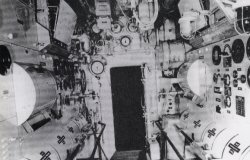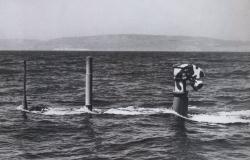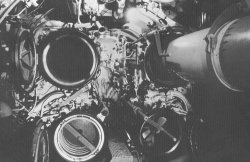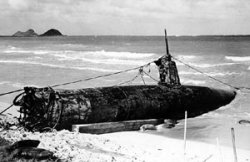

|
How a U-Boat Works
 |
||||||||
 |
 |
 |
 |
 |
 |
 |
 |
 |
The first attempt to use a submersible to sink a ship was made in 1776 during the American War of Independence. It did not succeed and was viewed by many as an unnecessary and troublesome vessel of war. However, by the end of The Second World War, the submarine was considered as the most powerful and destructive of all warships.
|
|
|
|
Authored by Uboataces |

|
Unlike nuclear submarines, which could dive to depths of over 1,000 feet, travel thousands of miles submerged and remain on patrol for months at a time, the u-boat can operate submerged only for brief periods at a time. For the U-boat force, it was considered as a torpedo boat, with the special capability to submerge for attack or as a defensive measure – hence giving rise to the name Undersea Boat or U-boat. Even so, a U-boat is a highly sophisticated vessel of war, with hundreds of precision controls and a 45-man crew to operate.
To withstand sea water pressure, the crew and vital machinery are housed within a strong watertight steel cylinder, known as the pressure hull. Fitted outside the pressure hull is an external outer hull, a much thinner aerodynamic hull which streamlines the U-boat for underwater movement. Rudders and hydroplanes are mounted on the outer hull while the main ballast tanks are housed within. When submerged, a U-boat is virtually blind. In order to navigate underwater, special devices, which correspond to the eyes and ears are fitted to the outer hull.
On the surface, a U-boat operates much like any other vessel. Driven forward (or backward) by its propellers, rudders steer the boat left or right. It has to be in motion in order to make a turn and is subject to the shifts of wind and tide. Unlike a surface ship, a U-boat may also adjust its buoyancy, or ability to sink or float. When the ballast tanks are empty, the U-boat displaces positive buoyancy and floats to the surface. When the ballast tanks are flooded with water, the U-boat sinks to the bottom (negative buoyancy). To surface again, compressed air is blown into the ballast tanks, displacing ballast water from the tanks. This way, a U-boat is able to control its buoyancy so that it weighs exactly the same weight as the water surrounding it (neutral buoyancy). In this condition, it neither sinks nor float. Thus, a U-boat is able to rise or sink to the depths solely by manipulating its buoyancy. Buoyancy had to be kept in check often as it varies according to the amount of fuel onboard, ammunition expended, ocean depth and salinity of water. Buoyancy can change rapidly when torpedoes are launched. A ton of positive buoyancy is created when a torpedo leaves its tube, and has to be offset immediately with ballast water to prevent the U-boat from popping to the surface.
When at rest or moving slowly underwater, a U-boat has to be handled carefully as it has a tendency to tip up or down into a vertical position. In shallow water, it can rest on the sea bed. When moving forward, a pair of hydroplanes controls the vessel’s depth. U-boat commanders prefer to keep their boat at neutral buoyancy. In this condition, the boat can dive or surface rapidly without constant dependence on the limited compressed air.
The main propulsion of the U-boat is the diesel engine – of which there are two, one on each side (port and starboard). These engines consume outside air and were operable only on the surface. Later in the war, a special pipe (snorkel) was developed to draw outside air so that the diesel engines could operate while the submarine is just below the surface at periscope depth.

|

|
| Onboard the electric motor room of U-889, a Type IXC. | The snorkel allows a U-boat to run its diesel engines when submerged. The observation scope is seen on the left, the attack periscope in the middle and snorkel on the right. It is fitted with a shutoff valve to prevent sea water from seeping in when the U-boat runs too deep. |
At greater depths, the U-boat is driven by electric motors using electricity drawn from giant internal batteries. When these are depleted, they must be recharged. This is done by traveling on the surface, or while snorkeling at periscope depth. The diesel engines are used to turn the electric motors so that they act as dynamos (generators) to recharge the depleted batteries. For rapid recharge, both diesel engines would be clutched onto the electric motors. For maximum range, one diesel engine would be clutched to an electric motor – which in turn acted as a generator to drive the other electric motor. Both propellers were turning in this way with only one diesel running.
Atop the U-boat, the conning tower rises amidships. When surfaced, the U-boat is steered from the top of the conning tower. When submerged, it is operated from a control room directly below the conning tower. Inside the pressure hull, pressure doors divide the watertight bulkheads into compartments, which contain the machinery, armament, stores and living quarters.
So that the U-boat can view surface activity without being spotted, it is fitted with periscopes. Some U-boats are fitted with two periscopes, an attack periscope for observing and targeting surface ships and an observation periscope for scanning the horizon for aircraft. These are further fitted with magnification lenses which zoom mode could be toggled similar to a camera’s zoom lens.
The main armament of the U-boat is the torpedo. Mounted primarily on the forward end, some models also had rear torpedo tubes to allow for forward and backward targeting. Spare torpedoes were carried both internally, and externally beneath the outer hull. External torpedoes had to be reloaded on the surface, which was a risky exercise as diving was impossible until the transfer was complete. Designed to travel just beneath the ocean line, torpedoes are launched on the surface or at periscope depth. They could not be launched any deeper because the U-boat commander could not see the target. Later in the war, acoustic homing torpedoes were developed, which steer themselves automatically towards the propeller noise generated by the target ship. U-boats can also lay mines from their torpedo tubes. The ordnance was discharged from the tube by compressed air or by hydraulics.
Another development of the U-boat was the midget submarine. First developed during the Second World War, it was used mostly to attack anchored warships. The two main types were “human torpedoes” and “midget submarines”. The human torpedo was launched from a submarine just outside an enemy harbor and involved two frogmen sitting on a torpedo which steered it to its target. A timed warhead was attached to the enemy ship’s hull, the frogmen then withdrew leaving the timed fuse to detonate the warhead. Midget submarines were manned by a crew of 2 to 5. They were designed to lay large charges with timed fuses on the sea bed, just beneath the enemy warship so they blew up underneath the ship. This kind of attack would often break the ship’s hull in two.

|

|
| Forward torpedo room of U-505. World war 2 torpedoes were very fickle and had to be pulled from its tube and serviced every two or three days. | Japanese midget submarines also took part in the attack on Pearl Harbor. |
During the war, two British battleships were sunk in 1941 while anchored in the harbor of Alexandria, Egypt by Italian human torpedoes. In 1943, British midget submarines crippled the German battleship Tirpitz while at anchor in Altefjord, Norway. Midget submarines were also used with varying success by the German and Japanese navies. The US Navy however did not pursue the idea with the conception that the effort required did not justify the gains.



